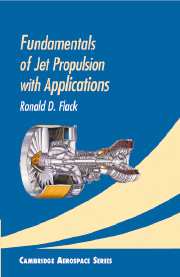11 - Matching of Gas Turbine Components
Published online by Cambridge University Press: 05 June 2012
Summary
Introduction
In the previous seven chapters, much emphasis has been placed on the analysis and design of individual components of gas turbines. On the other hand, in Chapters 2 and 3 cycle analyses are presented for ideal and nonideal engines as a whole in which the different components are integrated into a system. However, in Chapter 3, component efficiencies and some characteristics are assumed or assigned a priori for the overall cycle analyses. In general, however, the previous seven chapters demonstrate, through the use of either theoretical analyses or empirical characteristic curves (or “maps”), that component efficiencies and other operating characteristics change significantly at different conditions–for example, at different flow rates and rotational speeds.
To understand the overall effects of changing operating conditions, one can consider an engine initially at some steady-state operating condition. However, as the fuel injection rate in the burner is changed, the turbine inlet temperature and pressure are changed. Thus, the turbine will change rotational speeds. Because the turbine and compressor are on the same shaft, however, this change in rotational speed in turn changes the ingested mass flow rate and pressure ratio developed by the compressor, which influences the burner inlet pressure and the turbine inlet pressure, and so on. Eventually, the engine will again reach a different steady-state operating condition.
- Type
- Chapter
- Information
- Fundamentals of Jet Propulsion with Applications , pp. 481 - 524Publisher: Cambridge University PressPrint publication year: 2005



